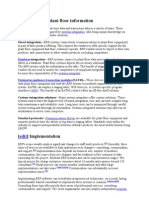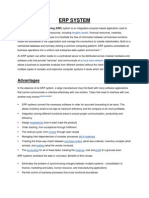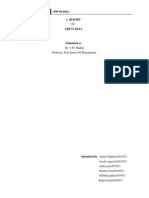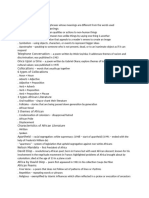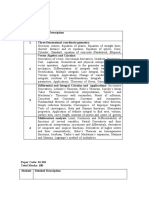Enterprise Resource Planning
Enterprise Resource Planning
Uploaded by
vvek87Copyright:
Available Formats
Enterprise Resource Planning
Enterprise Resource Planning
Uploaded by
vvek87Copyright
Available Formats
Share this document
Did you find this document useful?
Is this content inappropriate?
Copyright:
Available Formats
Enterprise Resource Planning
Enterprise Resource Planning
Uploaded by
vvek87Copyright:
Available Formats
Enterprise resource planning (ERP) integrates internal and external management information across an entire organization, embracing finance/accounting,
manufacturing, sales and service, customer relationship management, etc. ERP systems automate this activity with an integrated software application. Its purpose is to facilitate the flow of information between all business functions inside the boundaries of the organization and manage the connections to outside stakeholders.[1] ERP systems can run on a variety of hardware and network configurations, typically employing a database as a repository for information.[2] ERP systems typically include the following characteristics:
An integrated system that operates in real time (or next to real time), without relying on periodic updates.[citation needed] A common database, which supports all applications. A consistent look and feel throughout each module. Installation of the system without elaborate application/data integration by the Information Technology (IT) department.[3]
Finance/Accounting General ledger, payables, cash management, fixed assets, receivables, budgeting, consolidation Human resources payroll, training, benefits, 401K, recruiting, diversity management Manufacturing Engineering, bill of materials, work orders, scheduling, capacity, workflow management, quality control, cost management, manufacturing process, manufacturing projects, manufacturing flow, activity based costing, product lifecycle management Supply chain management Order to cash, inventory, order entry, purchasing, product configurator, supply chain planning, supplier scheduling, inspection of goods, claim processing, commissions Project management Costing, billing, time and expense, performance units, activity management Customer relationship management Sales and marketing, commissions, service, customer contact, call center support Data services Various "selfservice" interfaces for customers, suppliers and/or employees Access control Management of user privileges for various processes
Contents
[hide]
1 History o 1.1 Origin of "ERP" o 1.2 Expansion 2 Components 3 Best practices
4 Modularity 5 Connectivity to plant floor information 6 Implementation o 6.1 Process preparation o 6.2 Configuration o 6.3 Customization o 6.4 Extensions o 6.5 Data migration 7 Comparison to specialpurpose applications o 7.1 Advantages o 7.2 Disadvantages 8 See also 9 References 10 Further reading
[edit] History
[edit] Origin of "ERP"
In 1990 Gartner Group first employed the acronym ERP[4] as an extension of material requirements planning (MRP), later manufacturing resource planning[5][6] and computerintegrated manufacturing. Without supplanting these terms, ERP came to represent a larger whole, reflecting the evolution of application integration beyond manufacturing.[7] Not all ERP packages were developed from a manufacturing core. Vendors variously began with accounting, maintenance and human resources. By the mid1990s ERP systems addressed all core functions of an enterprise. Beyond corporations, governments and nonprofit organizations also began to employ ERP systems.[8]
[edit] Expansion
ERP systems experienced rapid growth in the 1990s because the year 2000 problem and introduction of the Euro disrupted legacy systems. Many companies took this opportunity to replace such systems with ERP. This rapid growth in sales was followed by a slump in 1999 after these issues had been addressed.[9] ERP systems initially focused on automating back office functions that did not directly affect customers and the general public. Front office functions such as customer relationship management (CRM) dealt directly with customers, or ebusiness systems such as e commerce, egovernment, etelecom, and efinance, or supplier relationship management (SRM) became integrated later, when the Internet simplified communicating with external parties.[citation needed] "ERP II" was coined in the early 2000s. It describes webbased software that allows both employees and partners (such as suppliers and customers) realtime access to the systems. "Enterprise application suite" is an alternate name for such systems.[citation needed]
[edit] Components
Transactional database Management portal/dashboard Business intelligence system Customizable reporting External access via technology such as web services Search Document management Messaging/chat/wiki Workflow management
[edit] Best practices
Best practices are incorporated into most ERP systems. This means that the software reflects the vendor's interpretation of the most effective way to perform each business process. Systems vary in the convenience with which the customer can modify these practices.[10] Companies that implemented industry best practices reduced timeconsuming project tasks such as configuration, documentation, testing and training. In addition, best practices reduced risk by 71% when compared to other software implementations.[11] The use of best practices eases compliance with requirements such as IFRS, Sarbanes-Oxley, or Basel II. They can also help comply with de facto industry standards, such as electronic funds transfer. This is because the procedure can be readily codified within the ERP software and replicated with confidence across multiple businesses who share that business requirement.[citation needed]
[edit] Modularity
Most systems are modular to permit automating some functions but not others. Some common modules, such as finance and accounting, are adopted by nearly all users; others such as human resource management are not. For example, a service company probably has no need for a manufacturing module. Other companies already have a system that they believe to be adequate. Generally speaking, the greater the number of modules selected, the greater the integration benefits, but also the greater the costs, risks and changes involved.
[citation needed]
[edit] Connectivity to plant floor information
ERP systems connect to realtime data and transaction data in a variety of ways. These systems are typically configured by systems integrators, who bring unique knowledge on process, equipment, and vendor solutions. Direct integrationERP systems connectivity (communications to plant floor equipment) as part of their product offering. This requires the vendors to offer specific support for the plant floor equipment that their customers operate. ERP vendors must be expert in their own products, and connectivity to other vendor products, including competitors. Database integrationERP systems connect to plant floor data sources through staging tables in a database. Plant floor systems deposit the necessary information into the database.
The ERP system reads the information in the table. The benefit of staging is that ERP vendors do not need to master the complexities of equipment integration. Connectivity becomes the responsibility of the systems integrator. Enterprise appliance transaction modules (EATM)These devices communicate directly with plant floor equipment and with the ERP system via methods supported by the ERP system. EATM can employ a staging table, Web Services, or systemspecific program interfaces (APIs). The benefit of an EATM is that it offers an offtheshelf solution. Customintegration solutionsMany system integrators offer custom solutions. These systems tend to have the highest level of initial integration cost, and can have a higher long term maintenance and reliability costs. Long term costs can be minimized through careful system testing and thorough documentation. Customintegrated solutions typically run on workstation or server class computers. Standard protocolsCommunications drivers are available for plant floor equipment and separate products have the ability to log data to staging tables. Standards exist within the industry to support interoperability between software products, the most widely known being OPC[12]
[edit] Implementation
ERP's scope usually implies significant changes to staff work processes and practices.[13] Generally, three types of services are available to help implement such changesconsulting, customization, and support.[13] Implementation time depends on business size, number of modules, customization, the scope of process changes, and the readiness of the customer to take ownership for the project. Modular ERP systems can be implemented in stages. The typical project for a large enterprise consumes about 14 months and requires around 150 consultants.[14] Small projects can require months; multinational and other large implementations can take years.[citation needed] Customization can substantially increase implementation times.[14]
[edit] Process preparation
Implementing ERP typically requires changing existing business processes.[15] Poor understanding of needed process changes prior to starting implementation is a main reason for project failure.[16] It is therefore crucial that organizations thoroughly analyze business processes before implementation. This analysis can identify opportunities for process modernization. It also enables an assessment of the alignment of current processes with those provided by the ERP system. Research indicates that the risk of business process mismatch is decreased by:
linking current processes to the organization's strategy; analyzing the effectiveness of each process; understanding existing automated solutions.[17][18]
ERP implementation is considerably more difficult (and politically charged) in decentralized organizations, because they often have different processes, business rules, data semantics, authorization hierarchies and decision centers.[19] This may require migrating some business
units before others, delaying implementation to work through the necessary changes for each unit, possibly reducing integration (e.g. linking via Master data management) or customizing the system to meet specific needs.[citation needed] A potential disadvantage is that adopting "standard" processes can lead to a loss of competitive advantage. While this has happened, losses in one area often offset by gains in other areas, increasing overall competitive advantage.[20][21]
[edit] Configuration
Configuring an ERP system is largely a matter of balancing the way the customer wants the system to work with the way it was designed to work. ERP systems typically build many changeable parameters that modify system operation. For example, an organization can select the type of inventory accountingFIFO or LIFOto employ, whether to recognize revenue by geographical unit, product line, or distribution channel and whether to pay for shipping costs when a customer returns a purchase.[citation needed]
[edit] Customization
When the system doesn't offer a particular feature, the customer can rewrite part of the code, or interface to an existing system. Both options add time and cost to the implementation process and can dilute system benefits. Customization inhibits seamless communication between suppliers and customers who use the same ERP system uncustomized.[citation needed] Key differences between customization and configuration include:
Customization is always optional, whereas the software must always be configured before use (e.g., setting up cost/profit center structures, organisational trees, purchase approval rules, etc.) The software was designed to handle various configurations, and behaves predictably in any allowed configuration. The effect of configuration changes on system behavior and performance is predictable and is the responsibility of the ERP vendor. The effect of customization is less predictable, is the customer's responsibility and increases testing activities. Configuration changes survive upgrades to new software versions. Some customizations (e.g. code that uses predefined "hooks" that are called before/after displaying data screens) survive upgrades, though they require retesting. Other customizations (e.g. those involving changes to fundamental data structures) are overwritten during upgrades and must be reimplemented.
Customization can be expensive and complicated, and can delay implementation. Nevertheless, customization offers the potential to obtain competitive advantage vis--vis companies using only standard features.
[edit] Extensions
ERP systems can be extended with thirdparty software. ERP vendors typically provide access to data and functionality through published interfaces. Extensions offer features such as:[citation needed]
archiving, reporting and republishing; capturing transactional data, e.g. using scanners, tills or RFID access to specialized data/capabilities, such as syndicated marketing data and associated trend analytics.
[edit] Data migration
Data migration is the process of moving/copying and restructuring data from an existing system to the ERP system. Migration is critical to implementation success and requires significant planning. Unfortunately, since migration is one of the final activities before the production phase, it often receives insufficient attention. The following steps can structure migration planning:[22]
Identify the data to be migrated Determine migration timing Generate the data templates Freeze the toolset Decide on migration-related setups Define data archiving policies and procedures.
[edit] Comparison to specialpurpose applications
[edit] Advantages
The fundamental advantage of ERP is that integrating the myriad processes by which businesses operate saves time and expense. Decisions can be made more quickly and with fewer errors. Data becomes visible across the organization. Tasks that benefit from this integration include[23]:
Sales forecasting, which allows inventory optimization Order tracking, from acceptance through fulfillment Revenue tracking, from invoice through cash receipt Matching purchase orders (what was ordered), inventory receipts (what arrived), and costing (what the vendor invoiced)
ERP systems centralize business data, bringing the following benefits:
They eliminate the need to synchronize changes between multiple systems consolidation of finance, marketing and sales, human resource, and manufacturing applications They enable standard product naming/coding. They provide a comprehensive enterprise view (no "islands of information"). They make realtime information available to management anywhere, any time to make proper decisions. They protect sensitive data by consolidating multiple security systems into a single structure.[24]
[edit] Disadvantages
Customization is problematic. Reengineering business processes to fit the ERP system may damage competitiveness and/or divert focus from other critical activities ERP can cost more than less integrated and/or less comprehensive solutions. High switching costs increase vendor negotiating power vis a vis support, maintenance and upgrade expenses. Overcoming resistance to sharing sensitive information between departments can divert management attention. Integration of truly independent businesses can create unnecessary dependencies. Extensive training requirements take resources from daily operations.
[edit] See also
List of ERP software packages List of ERP vendors Accounting software Advanced planning and scheduling APICS Bill of materials (BOM) Business process management Configurable BOM (CBOM) CEMLI Document automation Data migration Enterprise feedback management (EFM) Enterprise planning systems Enterprise system E-procurement ERP modeling ERP for IT ERP system selection methodology Information technology management List of project management software Management information system Manufacturing operations management Modular BOM (MBOM) Order to cash Service management Software as a service Supply chain management Warehouse management system
You might also like
- Example Pto - ApplicationDocument3 pagesExample Pto - ApplicationByron TorioNo ratings yet
- Zapi Controller CodesDocument17 pagesZapi Controller CodesMario71% (7)
- Enterprise Resource PlanningDocument4 pagesEnterprise Resource PlanningNithin CoolNo ratings yet
- Enterprise Resource Planning (Erp) the Great Gamble: An Executive’S Guide to Understanding an Erp ProjectFrom EverandEnterprise Resource Planning (Erp) the Great Gamble: An Executive’S Guide to Understanding an Erp ProjectRating: 4.5 out of 5 stars4.5/5 (5)
- Polina Kondratiuk: Certificate of AchievementDocument2 pagesPolina Kondratiuk: Certificate of AchievementПолина КондратюкNo ratings yet
- Panduan DOAJDocument42 pagesPanduan DOAJmuhammad ichwanNo ratings yet
- Enterprise Resource PlanningDocument8 pagesEnterprise Resource PlanningCharith LiyanageNo ratings yet
- Enterprise Resource Planning: From Wikipedia, The Free EncyclopediaDocument12 pagesEnterprise Resource Planning: From Wikipedia, The Free EncyclopediaRavindra Pratap SinghNo ratings yet
- (January 2011) :) +-+) - /#$/ ++0 1 +,#, 2 D 3 R 0 2 ') +2, 2! D# r4Document12 pages(January 2011) :) +-+) - /#$/ ++0 1 +,#, 2 D 3 R 0 2 ') +2, 2! D# r4Muhammad Anser MalikNo ratings yet
- Enterprise Resource Planning (ERP) Systems Integrate Internal and ExternalDocument14 pagesEnterprise Resource Planning (ERP) Systems Integrate Internal and ExternalYl WongNo ratings yet
- ? A ? A ??? A A ?! - ? D ?" ? R ?# ? ?? ?? ?$ ? ? A ? - ?% D ?! R ?&? Å ? ?? ' ?Document11 pages? A ? A ??? A A ?! - ? D ?" ? R ?# ? ?? ?? ?$ ? ? A ? - ?% D ?! R ?&? Å ? ?? ' ?Adarsh KumarNo ratings yet
- Characteristics: Enterprise Resource Planning (ERP) Systems Integrate Internal and ExternalDocument7 pagesCharacteristics: Enterprise Resource Planning (ERP) Systems Integrate Internal and Externalsaurabhrai.itbhu7140No ratings yet
- Enterprise Resource Planning2Document11 pagesEnterprise Resource Planning2Sandeep GuptaNo ratings yet
- Enterprise Resource PlanningDocument9 pagesEnterprise Resource PlanningAbelly WeremaNo ratings yet
- Connectivity To Plant Floor Information: Systems IntegratorsDocument4 pagesConnectivity To Plant Floor Information: Systems IntegratorstaffyguyNo ratings yet
- Project ReportDocument27 pagesProject ReportBharti RaiNo ratings yet
- Enterprise Resource PlanningDocument8 pagesEnterprise Resource PlanningPechetaNo ratings yet
- Erp System: AdvantagesDocument4 pagesErp System: AdvantagesAnand Thorat100% (1)
- Enterprise Resource PlanningDocument5 pagesEnterprise Resource PlanningNishanth JohnsonNo ratings yet
- Enterprise Resource Planning: This Article Needs AdditionalDocument8 pagesEnterprise Resource Planning: This Article Needs Additionalrambooks25No ratings yet
- Enterprise Resource PlanningDocument11 pagesEnterprise Resource PlanningThiagarajan100% (1)
- ERP-Enterprise ReSoUrse & PlanningDocument22 pagesERP-Enterprise ReSoUrse & PlanninginnomanikNo ratings yet
- VishalDocument8 pagesVishalVishal SharmaNo ratings yet
- Enterprise Resource PlanningDocument10 pagesEnterprise Resource PlanningHasnatAbbaceNo ratings yet
- C (C) Is An Integrated Computer-Based System Used ToDocument9 pagesC (C) Is An Integrated Computer-Based System Used ToragupathirajaramNo ratings yet
- Enterprise Resource PlanningDocument5 pagesEnterprise Resource PlanningkavithagowriNo ratings yet
- 43.enterprise Resource PlanningDocument5 pages43.enterprise Resource PlanningmercatuzNo ratings yet
- A Project Report On ERPDocument61 pagesA Project Report On ERPManish Singh0% (1)
- Enterprise Resource Planning (ERP)Document10 pagesEnterprise Resource Planning (ERP)Bhushan BariNo ratings yet
- Enterprise Resource Planning (Document19 pagesEnterprise Resource Planning (Ninad KhuleyNo ratings yet
- C Enterprise Resource PlanningerpDocument11 pagesC Enterprise Resource Planningerpchittesh23100% (1)
- Assignment:Mit: Implementation of Erp in Manufacturing SectorDocument8 pagesAssignment:Mit: Implementation of Erp in Manufacturing SectorVimalan MathaiyanNo ratings yet
- A Term Paper: Software Project ManagementDocument24 pagesA Term Paper: Software Project ManagementdimpibNo ratings yet
- New Microsoft Word DocumentDocument6 pagesNew Microsoft Word DocumentRahul BangaNo ratings yet
- Origin of "ERP"Document4 pagesOrigin of "ERP"kanika_bhardwaj_2No ratings yet
- Literature Review On Enterprise Resource Planning (ERP)Document6 pagesLiterature Review On Enterprise Resource Planning (ERP)Sheel ShahNo ratings yet
- CH 1 Introduction To Enterprise Resource Planning SystemsDocument20 pagesCH 1 Introduction To Enterprise Resource Planning SystemsPurdianta YoNo ratings yet
- Enterprise Resource PlanningDocument23 pagesEnterprise Resource PlanningAhmed BilalNo ratings yet
- Erp InformationDocument10 pagesErp InformationCHAITANYA SIVANo ratings yet
- What Is ERPDocument15 pagesWhat Is ERPjoann16100% (1)
- Enterprise Resource Planning (ERP) :: Origin of The TermDocument10 pagesEnterprise Resource Planning (ERP) :: Origin of The TermGoNo ratings yet
- Jaipuria Institute of Management LucknowDocument9 pagesJaipuria Institute of Management Lucknowalseran4ttyNo ratings yet
- ERP-Enterprise Resource Planning - WikipediaDocument17 pagesERP-Enterprise Resource Planning - WikipediaEkaterina JazminNo ratings yet
- Technologies For Development of The Information Systems: From ERP To E-GovernmentDocument16 pagesTechnologies For Development of The Information Systems: From ERP To E-GovernmentShah Maqsumul Masrur TanviNo ratings yet
- AIM 7& 8 UnitsDocument14 pagesAIM 7& 8 UnitsTejaswi GeddamNo ratings yet
- Enterprise Resource PlanningDocument13 pagesEnterprise Resource PlanningCarlos Oreste Cruz MartinezNo ratings yet
- Iem Unit 6Document12 pagesIem Unit 6vamsibuNo ratings yet
- Enterprise Resource Planning - WikipediaDocument12 pagesEnterprise Resource Planning - WikipediaNITISH KUMARNo ratings yet
- Applications and Benefits of ERP ImplementationsDocument9 pagesApplications and Benefits of ERP Implementationsfkiyao81100% (1)
- ReviewersDocument13 pagesReviewersshaaisoo24No ratings yet
- Enterprise Resource PlanningDocument11 pagesEnterprise Resource PlanningMohammed KemalNo ratings yet
- Enterprise Resource Planning (ERP)Document24 pagesEnterprise Resource Planning (ERP)Nilmani KumarNo ratings yet
- Enterprise Resource PlannningDocument153 pagesEnterprise Resource PlannningSuraj PrakashNo ratings yet
- ERP SoftwareDocument16 pagesERP SoftwareandreslomeNo ratings yet
- Introduction To ERP: ApplicationsDocument40 pagesIntroduction To ERP: Applicationsanup20janNo ratings yet
- Foundations For Understanding ERP Systems: Enterprise Resource PlanningDocument9 pagesFoundations For Understanding ERP Systems: Enterprise Resource PlanningFitha FathimaNo ratings yet
- Erp in Dell: September 10, 2011Document53 pagesErp in Dell: September 10, 2011Gautam GoelNo ratings yet
- ERP BasicsDocument21 pagesERP Basicsabhijitangul100% (2)
- Advantages and Disadvantages of ERPDocument3 pagesAdvantages and Disadvantages of ERPAmol Kasture0% (1)
- ERPDocument49 pagesERPDeep MalaniNo ratings yet
- LectraDocument38 pagesLectraNiharika SinhaNo ratings yet
- Implementation of Enterprise Resource PlanningDocument15 pagesImplementation of Enterprise Resource PlanningRakesh PalshetkarNo ratings yet
- J2A Architectural Design Studio: Admin SupervisorDocument2 pagesJ2A Architectural Design Studio: Admin SupervisorBernardNo ratings yet
- Kyambogo Univ 2fps 6 2021 22 Final Direct Entry Scheme AdvertDocument2 pagesKyambogo Univ 2fps 6 2021 22 Final Direct Entry Scheme AdvertAlmaz GetachewNo ratings yet
- English 8Document3 pagesEnglish 8gevangelista1122No ratings yet
- British Consumer Electronics BushDocument2 pagesBritish Consumer Electronics BushirfanmNo ratings yet
- Don't Adapt, Pro-Act: by Ichak Adizes and Shoham AdizesDocument3 pagesDon't Adapt, Pro-Act: by Ichak Adizes and Shoham AdizeszmikulNo ratings yet
- Remote Operators SW Kit-A1-SmDocument38 pagesRemote Operators SW Kit-A1-SmAlfred Vivien BossonNo ratings yet
- Nonincendive Electrical Equipment For Use in Class I and II, Division 2 and Class III, Divisions 1 and 2 Hazardous (Classified) LocationsDocument46 pagesNonincendive Electrical Equipment For Use in Class I and II, Division 2 and Class III, Divisions 1 and 2 Hazardous (Classified) LocationsMahdy MazinyNo ratings yet
- Mhps-Ts Newsletter: MHPS Technical Services CorporationDocument17 pagesMhps-Ts Newsletter: MHPS Technical Services Corporationjonel.javierNo ratings yet
- MV Design Guide - Circuit Breaker SpecificationDocument10 pagesMV Design Guide - Circuit Breaker Specificationhadi saadNo ratings yet
- The Ultimate Guide To Office CleanlinessDocument7 pagesThe Ultimate Guide To Office CleanlinessSafiee AliNo ratings yet
- Facial Emotion Recognition System Through Machine Learning ApproachDocument7 pagesFacial Emotion Recognition System Through Machine Learning ApproachDivya SuvarnaNo ratings yet
- Machine InfDocument34 pagesMachine InfRakesh Yadav M NNo ratings yet
- Toksikologi MerkuriDocument31 pagesToksikologi MerkuriRisvy MokoalungNo ratings yet
- Chem 320 Heterogeneous EquilibriumDocument4 pagesChem 320 Heterogeneous Equilibriumlinwryn qNo ratings yet
- Lit 1Document9 pagesLit 1April Joy BalaguerNo ratings yet
- Kathleen McClaskey and Barbara Bray - Redesigning A Standards-Based ClassroomDocument7 pagesKathleen McClaskey and Barbara Bray - Redesigning A Standards-Based ClassroomClassroom 2.0 BookNo ratings yet
- Measurement SheetDocument2 pagesMeasurement Sheetvikas sharmaNo ratings yet
- Use of Hand Tools: DescriptionDocument14 pagesUse of Hand Tools: DescriptionTawhid100% (1)
- RSX 35Document60 pagesRSX 35DaneNo ratings yet
- Paper Code: M 101 Total Marks: 100Document4 pagesPaper Code: M 101 Total Marks: 100ArchanaSinghNo ratings yet
- Longevity in Jaimini Astrology (Revised) Kakshya Vridhi and Kaksha Hrasa - With 2 Case StudiesDocument5 pagesLongevity in Jaimini Astrology (Revised) Kakshya Vridhi and Kaksha Hrasa - With 2 Case StudiesANTHONY WRITER100% (1)
- Module 3Document24 pagesModule 3Jessalyn JimenezNo ratings yet
- 4as Lesson Plan - Bada - Math 22Document6 pages4as Lesson Plan - Bada - Math 22Rejessa Mae BadaNo ratings yet
- Villanueva - Loadclassprogram 1st-Sem 2022Document2 pagesVillanueva - Loadclassprogram 1st-Sem 2022winslet villanuevaNo ratings yet
- Hindu Units of Time MeasurementDocument3 pagesHindu Units of Time MeasurementGirish TilakNo ratings yet
- Table Besi IwfDocument1 pageTable Besi IwfRusdi AnankNo ratings yet














